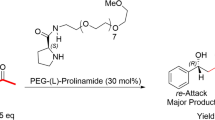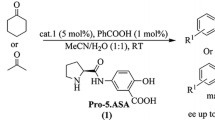Abstract
We examined the activity of a series of L-hydroxyproline derivatives in enantioselective α-amination reaction between diethyl azodicarboxylate and propanal both in organic and aqueous media. In organic media most of the catalysts showed high activity and enantioselectivities comparable to that accessible with L-proline that is among the best catalysts in the reaction. The catalysts showed good activity under aqueous conditions as well; however, only low enantioselectivities were obtained in this case, primarily due to the racemisation of the product under the reaction conditions. Thus, the attempted achiral acid/base additive-driven stereocontrol was not feasible on a practical level.






Similar content being viewed by others
References
List B (2002) J Am Chem Soc 124:5656–5657
Bøgevig A, Juhl K, Kumaragurubaran N, Zhuang W, Jørgensen KA (2002) Angew Chem Int Ed 41:1790–1793
Kumaragurubaran N, Juhl K, Zhuang W, Bøgevig A, Jørgensen KA (2002) J Am Chem Soc 124:6254–6255
Duthaler RO (2003) Angew Chem Int Ed 42:975–978
Bartók M (2010) Chem Rev 110:1663–1705
Escorihuela J, Burguete MI, Luis SV (2013) Chem Soc Rev 42:5595–5617
Franzén J, Marigo M, Fielenbach D, Wabnitz TC (2005) Kjærsgaard, Jørgensen KA. J Am Chem Soc 127:18296–18304
Dinér P, Kjærsgaard A, Lie MA, Jørgensen KA (2008) Chem Eur J 14:122–127
Blackmond DG, Moran A, Hughes M, Armstrong A (2010) J Am Chem Soc 132:7598–7599
Kanzian T, Lakhdar S, Mayr H (2010) Angew Chem Int Ed 49:9526–9529
Hein JE, Armstrong A, Blackmond DG (2011) Org Lett 13:4300–4303
Hein JE, Burés J, Y-H L, Hughes M, Houk KN, Armstrong A, Blackmond DG (2011) Org Lett 13:5644–5647
Sharma AK, Sunoj RB (2011) Chem Commun 47:5759–5761
Schmid MB, Zeitler K, Gschwind RM (2012) Chem Eur J 18:3362–3370
Fu A, Tian C, Li H, Li P, Chu T, Wang Z, Liu J (2015) Chem Phys 455:65–72
Darbre T, Machuqueiro M (2003) Chem Commun 1090–1091
Zhong L, Xiao J, Li C (2006) J Catal 243:442–445
Breslow R, Ramalingam V, Appayee C (2013) Orig Life Evol Biosph 43:323–329
Szőllősi G, Fekete M, Gurka AA, Bartók M (2014) Catal Lett 144:478–486
Gurka AA, Szőri K, Szőllősi G, Bartók M, London G (2015) Tetrahedron Lett 56:7201–7205
Gurka AA, Szőri K, Bartók M, London G (2016) Tetrahedron Asymm 27:936–942
Hayashi Y, Aratake S, Imai Y, Hibino K, Chen Q-Y, Yamaguchi J, Uchimaru T (2008) Chem Asian J 3:225–232
Msutu A, Hunter R (2014) Tetrahedron Lett 55:2295–2298
Mlynarski J, Baś S (2014) Chem Soc Rev 43:577–587
Bartók M, Dombi G (2014) Curr Green Chem 1:191–201
Chemical Computing Group Inc. (2004) Molecular Operating Environment (MOE). Sci. Comput. Instrum. Chemical Computing Group Inc., 1010 Sherbooke St. West, Suite #910, Montreal.
Halgren TA (2000) J Comput Chem 17:520–552
Labute P (2008) J Comput Chem 29:1693–1698
Devlin FJ, Finley JW, Stephens PJ, Frisch MJ (1995) J Phys Chem 99:16883–16902
Becke A, Becke A (1993) J Chem Phys 98:5648–5652
Frisch MJ, Trucks GW, Schlegel HB, Scuseria GE, Robb MA, Cheeseman JR, Scalmani G, Baron V, Mennucci B, Petersson GA, Nakatsuji H, Caricato M, Li X, Hratchian HP, Izmaylov AF, Bloino J, Zheng G, Sonnenberg JL, Hada M, Ehara M, Toyota K, Fukuda R, Hasegawa J, Ishida M, Nakajima T, Honda Y, Kitao O, Nakai H, Vreven T, Montgomery Jr JA, Peralta JE, Ogliaro F, Bearpark MJ, Heyd J, Brothers EN, Kudin KN, Staroverov VN, Kobayashi R, Normand J, Raghavachari K, Rendell AP, Burant JC, Iyengar SS, Tomasi J, Cossi M, Rega N, Millam NJ, Klene M, Knox JE, Cross JB, Bakken V, Adamo C, Jaramillo J, Gomperts R, Stratmann RE, Yazyev O, Austin AJ, Cammi R, Pomelli C, Ochterski JW, Martin RL, Morokuma K, Zakrzewski VG, Voth GA, Salvador P, Dannenberg JJ, Dapprich S, Daniels AD, Farkas Ö, Foresman JB, Ortiz JV, Cioslowski J, Fox DJ (2009) Gaussian09, Revision C.01. Wallinford, CT.
Marenich AV, Cramer CJ, Truhlar DG (2009) J Phys Chem B 113:6378–6396
For the synthesis of the catalysts, see refs 20 and 21.
Ötvös SB, Szloszar A, Mandity IM, Fülöp F (2015) Adv Synth Catal 357:3671–3680
Kotrusz P, Alemayehu S, Toma Š, Schmalz H-G, Adler, A (2005) Eur J Org Chem 4904–4911
Baumann T, Bächle M, Hartmann C, Bräse S (2008) Eur J Org Chem 2207–2212
Zhang Q, Parker E, Headley AD, Ni B (2010) Synlett 2453–2456
Acknowledgments
Financial support from the National Research, Development and Innovation Office, Hungary (OTKA Grants K 109278 and PD 115436), is gratefully acknowledged. Z. Szécsényi (Institute of Pharmaceutical Chemistry, University of Szeged) is acknowledged for technical support. M. S. was supported by a Magyary Zoltán fellowship within the framework of TÁMOP 4.2.4. A/2-11-1-2012-0001 (A2-MZPD-12-0139) and he is currently János Bolyai Research Scholar of the Hungarian Academy of Sciences (BO/00113/15/7). G. L. acknowledges the János Bolyai Research Scholarship from the Hungarian Academy of Sciences. We thank the anonymous reviewers for their insightful comments, which improved the quality of the manuscript.
Author information
Authors and Affiliations
Corresponding authors
Rights and permissions
About this article
Cite this article
Gurka, A.A., Szőri, K., Szőri, M. et al. Application of hydroxyproline derivatives in enantioselective α-amination reactions in organic and aqueous environments: a structure-activity relationship study. Struct Chem 28, 415–421 (2017). https://doi.org/10.1007/s11224-016-0873-z
Received:
Accepted:
Published:
Issue Date:
DOI: https://doi.org/10.1007/s11224-016-0873-z




